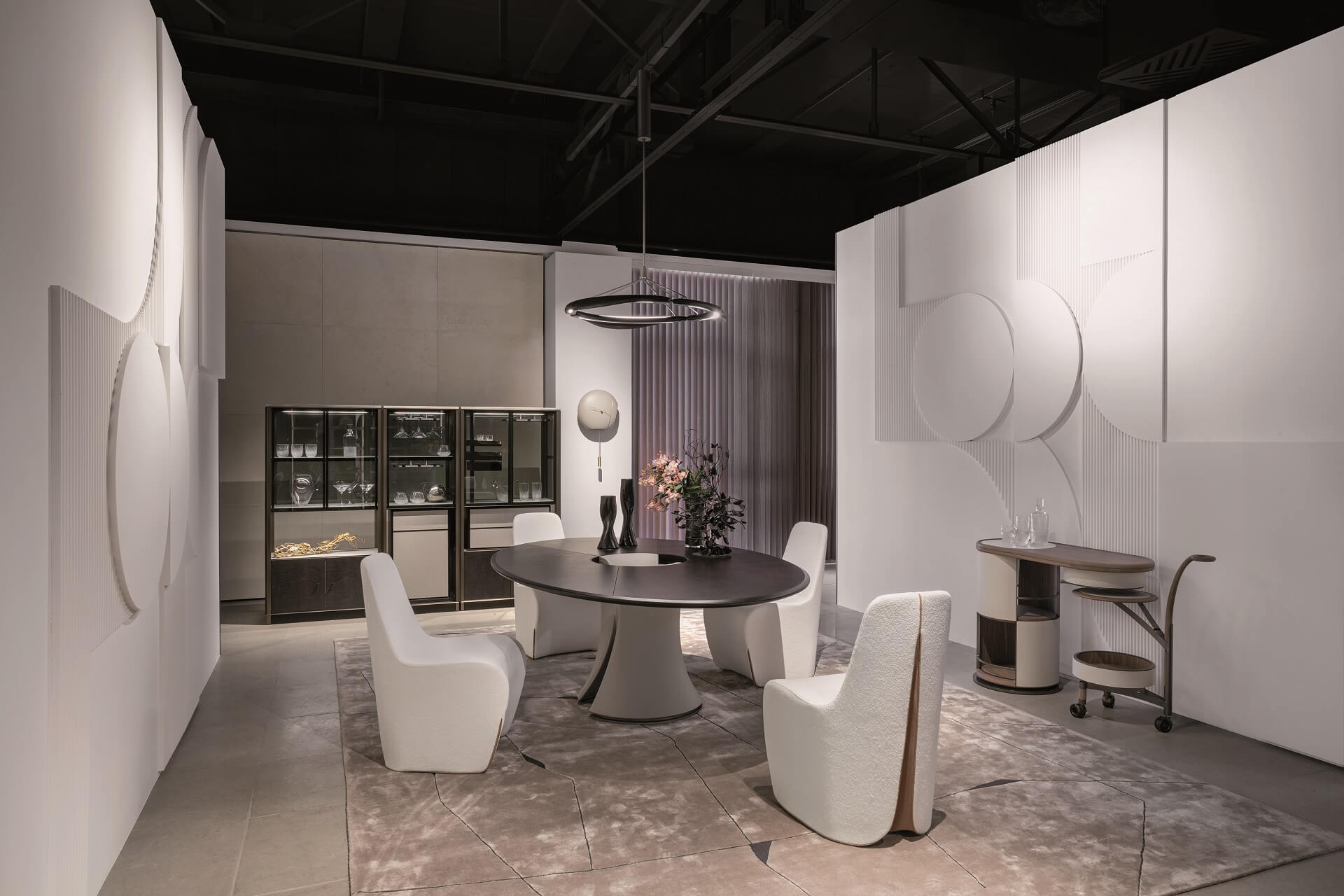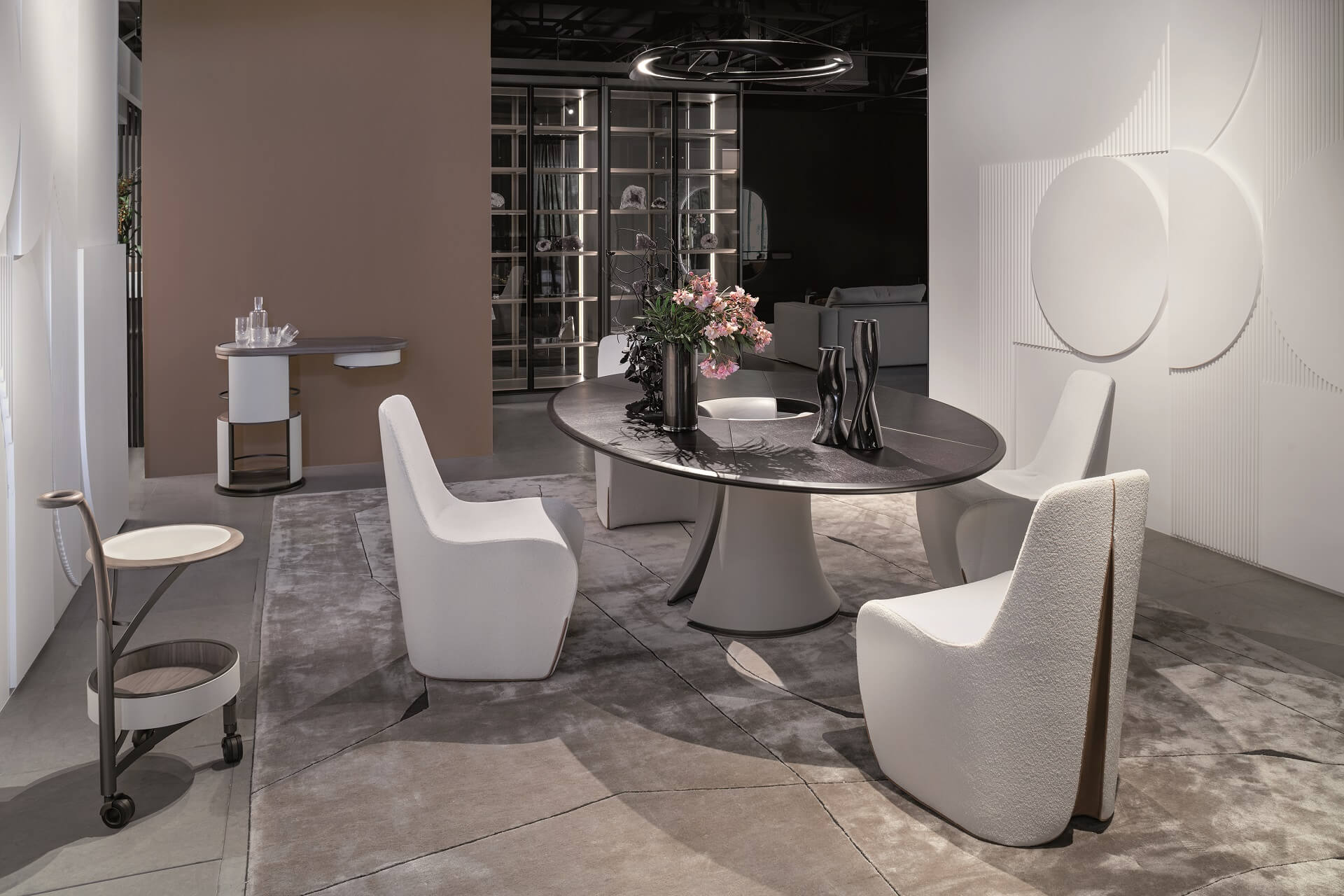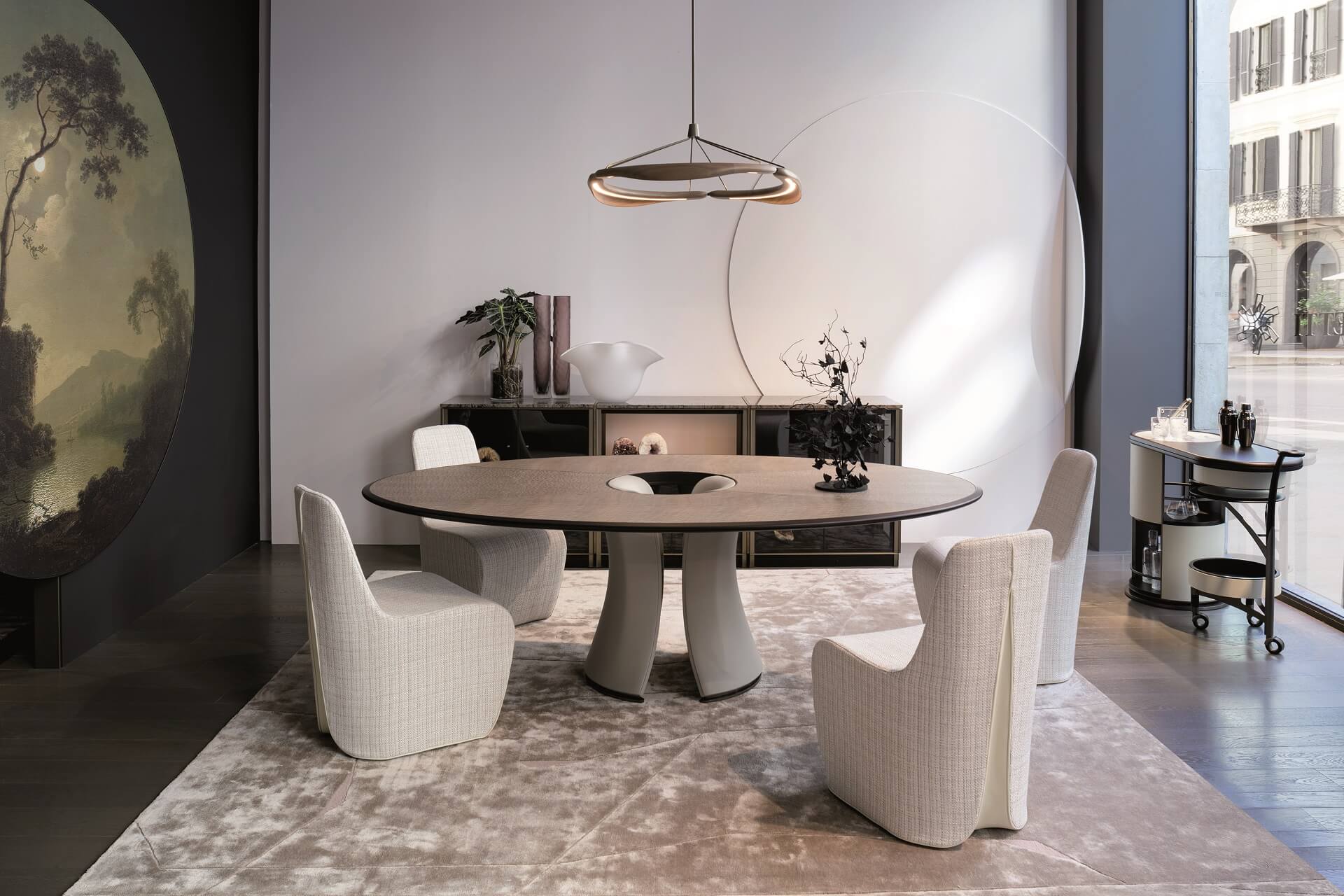Organic, soft shapes, geometric overlays and three-dimensional effects enliven the Giorgetti collections, expressing versatility, with great impact for a dynamic environment to be lived in naturally.
Vesper
Vesper, the sofa-system designed by Roberto Lazzeroni, subverts and goes beyond the traditional idea of the sofa to offer a dynamic and customisable concept. The element that defines the entire project is the base, which has been reduced to a simple sign, a platform on which the furnishing object comes to life in its eccentric sobriety
With its organic forms, Vesper interprets a certain fluidity of contemporary living in which sinuous lines design spaces with a pleasant visual and tactile softness. Elegant and sophisticated, the floorboards covered in leather or fabric contain seat cushions and upholstered backrests, aalso in leather or fabric, with completely removable covers
Vesper is available in a monochrome version made entirely of fabric or leather, or in a two-tone version that combines leather and fabric.
“The sofa is the place where many of our daily activities take place. The one in my house, for example, is very deep, which allows me to use it to read, relax or sleep, but also to work or eat something. I wanted to create an island that can be inserted into rooms, that moves naturally within the space. Thanks to its modularity, it is possible to define very varied compositions with great impact,” says designer Roberto Lazzeroni.
Clamp
“There are times when it is good to stop and realise that nothing more needs to be added”, commented Marco Bonelli and Marijana Radovic about Clamp coffee tables.
Clamp coffee tables are characterised by a refined interplay of joints, geometric overlaps, and glossy and matte finishes: the elements intersect each other to create an extremely elegant aesthetic minimalism. Citing Giorgetti’s cabinet-making tradition, Clamp recalls the clamp used by craftsmen and interprets it in the metal structure of the coffee table. Available in three heights, with leather, wood or painted glass tops and a lacquered edge with a liquid metal titanium effect, they can be assembled in a beautiful formal game that underlines their graphic sign.
Otto and Summa
In the usual sign of Giancarlo Bosio, the purity of geometric shapes comes alive in three-dimensional effects to create sculptural objects that furnish living spaces with sober elegance. The designer, with the Giorgetti Research Centre, presents two elegant interpretations of the cylinder with the Otto and Summa poufs. The essentiality of the solid is embellished with unexpected details that provide new and playful variations on the theme. In Summa, the cylinder has been broken down into vertical elements and then reassembled in a refined sum of colours and materials. The Otto pouf, on the other hand, plays on the surprise effect: the seat upholstered in leather or fabric suddenly reveals a removable, swivel table in painted steel.
Elsa
Giorgetti consolidates its collaboration with the M2Atelier studio with an articulated collection of tables, seats and accessories, including the Elsa armchair.
In an alternation of solids and voids, of opposing forces, Elsa features a walnut frame, available in natural, grey and dark wood finishes, which is completely revealed to become the distinctive sign of the project. A metal tubular frame hooks the seat as if in an embrace and supports the backrest. The cushions, with removable covers, can be upholstered in fabric, with the seat and backrest available in two different fabrics, leather or with a leather seat and fabric backrest or vice versa. A leather piping, in the same shade as the upholstery of the backrest structure, emphasises the profile of the cushions.
“Elsa is modern, fresh, light: it is a tribute to Elsa Peretti. It has many undiscovered details that we have, little by little, taken care of with love”, say Marco Bonelli and Marijana Radovic.
Houdini
Houdini, designed by Roberto Lazzeroni, is a sculptural object which, defined by the designer’s essential and soft sign, explores space and establishes a real dialogue with the surrounding environment. It is a jewel-object, a precious casket that holds a timeless charm.
“The aim was to create a piece of storage furniture that would have a fluid position in the home: from the living room to the sleeping area. It is a piece that escapes all classification. It’s not a sideboard, it’s not a storage unit, it’s not a bar cabinet: it’s a bit of all those things. I wanted it to be a mysterious piece of furniture, to have secrets and magic: it takes its name from this initial idea. In the two-door version, the columns are two trunks that open to reveal shelves, compartments and drawers. It is a sort of magic, it becomes a “house of things”, a box of wonders. The shape is inspired by the silos found in Lombardy’s rural areas, an element that is also often found in Aldo Rossi’s architecture,” says Roberto Lazzeroni.
In the search for detail, Houdini expresses the uniqueness of Giorgetti’s cabinet-making tradition of a perfect balance between form and function. The external appearance is composed of a play of inlays in Canaletto walnut or maple arranged according to the direction of the grain, vertical and horizontal, to obtain an iridescent effect on the surface.
The shape of the inlays has been designed by arranging perpendicular and inclined lines to create a curious optical effect: when you look at the cabinet from a distance, the inlays seem to tighten at the centre of the cabinet and then widen at the top and bottom.
Houdini is available in two versions, with one or two columns housing drawers, storage shelves, compartments, empty pocket trays and leather-finished doors that are revealed in the light of the LED system. For the single column version, it is possible to choose the direction of door opening: right or left. In the combination of materials typical of the Giorgetti collections, the internal shelves of Houdini are enriched with bronze or grey glass inserts, depending on the essence of the external inlays. The top has a drop-down riser upholstered in leather that reveals the internal compartments. Houdini with two columns is embellished with intimate and secret spaces, with two hidden compartments that can only be reached by magic.
“The double version is a structural and architectural object, it is like a sculpture; the single version becomes more private, a piece of furniture that you can become attached to and that can accompany you throughout your life,” explains Roberto Lazzeroni.
Houdini adapts perfectly to the living or sleeping area, to classic or contemporary atmospheres, to hold bar sets and tableware or clothing, jewellery and accessories, to become a distinguished and elegant companion in the living experience.
Ensō
The thousand-year-old philosophies of the Far East have inspired the Ensō table. While its name means circle in Japanese, its round shape, widely used in traditional calligraphy, has a deep meaning rooted in Zen Buddhism: it symbolises illumination, infinity and the absolute universe.
“We have interpreted this concept of everything, meaning the universe, and nothing, meaning emptiness, with a sculptural and graceful object that seems to arise from a void to open up like a calla lily,” revealed the M2Atelier designers. Made of wood, Enso is available in both round and elliptical top versions defined by walnut, mahogany or leather inserts. The central leg is upholstered in elegant leather. Optionally available, a Lazy Susan in extra clear glass with a solid canaletto walnut frame.
Tie
The Tie chair is characterised by its full volume. It is a monolithic object that captures the attention for its details: its silhouette seems to be discreet until it reveals a deep and seductive slit in the back, a leather insert that recalls certain haute couture creations. The frame is upholstered and the cover, which is completely removable, is available in fabric or leather.
“Miss Tie is jaunty and elegant: she is always well-dressed and fashionable, with her dress that falls to the floor and a tailored cut at the back. She looks good in company, but also on her own,” say the designers.




